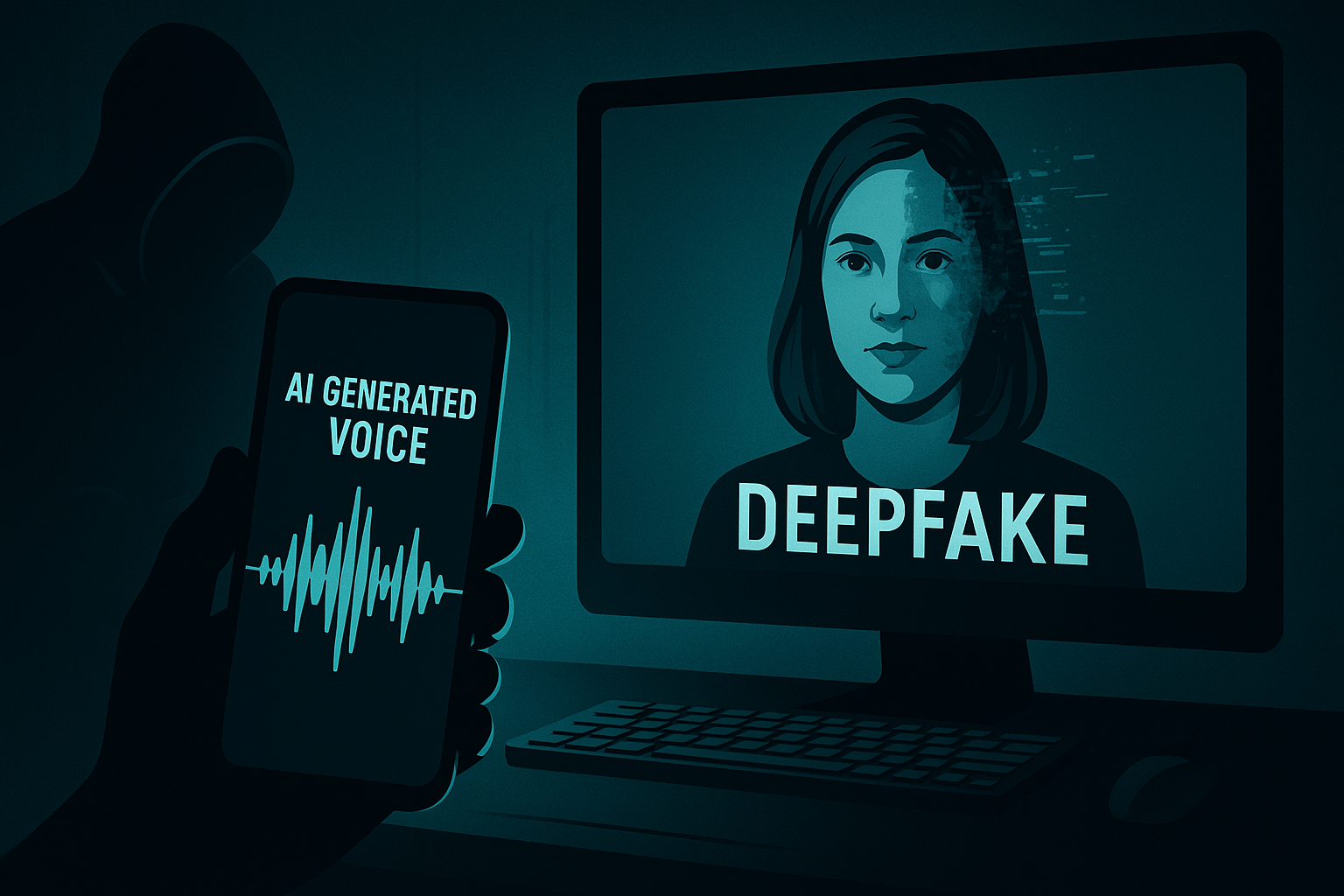The Deepfake Dilemma: How AI-Generated Content is Reshaping Business Security

In an era where digital trust is increasingly fragile, a new threat has emerged that challenges our fundamental assumptions about what we see and hear. AI-powered deepfakes—synthetically generated media that can convincingly impersonate real people—have rapidly evolved from novelty to nightmare, particularly for businesses navigating an increasingly complex security landscape.
The Rising Tide of Synthetic Media
The term "deepfake" entered our lexicon around 2017, but the technology has accelerated at a pace that has left many security experts alarmed. No longer confined to research labs or sophisticated operations, deepfake technology has been democratized, with user-friendly applications now available to anyone with basic technical skills and modest computing resources.
"What previously required specialized knowledge and significant computing power can now be accomplished with a smartphone app and a few minutes of sample audio," explains Dr. Maya Krishnan, cybersecurity researcher at the University of Toronto. "This accessibility has fundamentally changed the threat landscape for both individuals and organizations."
The statistics paint a troubling picture:
- According to VMware's 2023 Modern Bank Heists report, 66% of financial institutions reported an increase in deepfake-related fraud attempts
- The FBI's Internet Crime Complaint Center documented over 4,000 complaints related to voice cloning fraud in 2023 alone, with losses exceeding $40 million
- A study by Deloitte found that 78% of C-suite executives consider deepfake attacks a "significant" or "very significant" threat to their organization's reputation
When Seeing and Hearing Is No Longer Believing
The business implications of this technology extend far beyond isolated incidents of fraud. Consider these real-world scenarios that have already played out:
The CEO Voice Scam
In March 2023, a finance director at a Canadian manufacturing firm received an urgent call, apparently from the company's CEO, requesting an immediate wire transfer to secure a time-sensitive acquisition. The voice sounded authentic, referenced internal company details, and conveyed the appropriate sense of urgency. The transfer—approximately $620,000—was completed before anyone realized it was a sophisticated voice clone generated from the CEO's earnings call recordings and conference presentations.
The Employee Impersonation
A multinational corporation headquartered in Chicago discovered that an AI-generated likeness of their HR director had been used in a series of video calls with potential new hires. During these calls, the fake HR director collected sensitive personal information and instructed candidates to make "training program deposits" to secure their positions. The scam continued for weeks before being detected.
The Stock Price Manipulation
In a particularly alarming case from early 2024, deepfake videos appearing to show the CEO of a publicly-traded technology company making statements about missed earnings targets and potential regulatory issues were strategically released just before trading hours. The company's stock dropped 8% before the manipulations were identified and addressed, allowing opportunistic short-sellers to profit.
"These aren't hypothetical concerns anymore," notes James Watkins, former FBI cybercrime specialist and current security consultant. "We're seeing these attacks executed successfully against sophisticated organizations that previously thought they had robust security protocols."
The Technical Reality
Understanding how deepfake technology works is crucial for those tasked with defending against it. The current generation of synthetic media typically relies on two advanced AI approaches:
-
Generative Adversarial Networks (GANs) - Systems where two AI models work in opposition: one generates fake content while the other attempts to detect the forgery. Through this competitive process, the generator continuously improves until its outputs can fool even sophisticated detection systems.
-
Transformer-based models - Large language models similar to those powering conversational AI tools can now generate both text scripts and voice outputs that mimic specific individuals with uncanny accuracy.
The most sophisticated attacks combine multiple technologies:
- Voice cloning from as little as 30 seconds of sample audio
- Facial mapping and animation from photographs or video clips
- Natural language processing to capture speech patterns and verbal tics
- Contextual awareness based on publicly available information about the target
"What makes modern deepfakes particularly dangerous is their ability to incorporate contextual information," explains Dr. Sarah Nolan, AI ethics researcher at MIT. "A fraudster can scrape LinkedIn profiles, earnings calls, social media, and company announcements to create an impersonation that references real projects, colleagues, and corporate terminology."
The Business Impact
For North American businesses, the threats posed by deepfake technology fall into several critical categories:
Financial Fraud
The most immediate concern for many organizations is direct financial loss. Synthetic voice or video can be used to authorize fraudulent transactions, with criminals specifically targeting processes where verbal confirmation is considered a security measure. The average reported loss from successful voice-based CEO fraud in 2023 exceeded $300,000 per incident.
Reputational Damage
Deepfakes can be weaponized to damage brand integrity through fabricated statements or actions attributed to executives. Unlike traditional crises, deepfake incidents combine urgency with technological complexity, making effective response particularly challenging.
A 2023 survey by the Canadian Chamber of Commerce found that 62% of businesses believe a convincing deepfake incident involving their leadership would have "severe" or "extremely severe" reputational consequences.
Market Manipulation
For publicly traded companies, the risk extends to stock price manipulation through strategically timed deepfake releases. Even after debunking, the financial impact of these manipulations can persist, particularly for companies where market value is closely tied to leadership perception.
Operational Disruption
Beyond direct fraud, deepfakes create significant operational challenges. Security teams must devote resources to verification protocols, executives face increased scrutiny of their communications, and decision-making processes may slow as authentication steps multiply.
"We're seeing the emergence of a trust tax," says Michael Chen, Chief Information Security Officer for a major Canadian financial institution. "Every process that relies on voice or visual confirmation now requires additional verification steps, which impacts operational efficiency across the organization."
The Protection Playbook
While the threat landscape is evolving rapidly, organizations are not defenseless. A multi-layered approach to deepfake protection has emerged as the industry best practice:
Technical Countermeasures
Advanced detection technologies offer the first line of defense:
- Liveness detection - Systems that verify a person is physically present during video calls by detecting natural micro-movements and responses
- Audio watermarking - Embedding imperceptible signatures in authorized communications that can later be verified
- Multimodal analysis - Tools that examine both visual and audio components for inconsistencies that might not be apparent in either channel alone
Major tech firms including Microsoft, Google, and Canadian AI pioneer Sanctuary AI have developed detection systems specifically designed to identify synthetic media, with accuracy rates now exceeding 90% for many types of deepfakes.
Process Adaptation
Beyond technological solutions, organizations are implementing procedural changes:
- Multi-factor authentication for high-risk transactions that goes beyond voice confirmation
- Challenge question protocols incorporating personal knowledge unlikely to be available to fraudsters
- Out-of-band verification through separate, pre-established communication channels
- Transaction delay policies for requests that deviate from normal patterns
"The most effective protection comes from combining technical tools with human-centered processes," advises Rita Samson, Principal at Deloitte's Cyber Risk practice. "No single technological solution can match a thoughtfully designed verification workflow."
Employee Education
The human element remains critical, with companies investing heavily in awareness training:
- Recognition of deepfake warning signs
- Critical evaluation of unexpected communications
- Clear escalation pathways for suspicious interactions
- Regular simulations and testing of response protocols
A 2023 study by the Ponemon Institute found that organizations with comprehensive deepfake awareness programs experienced 64% fewer successful social engineering attacks compared to those without such training.
Legal and Regulatory Preparation
Forward-thinking organizations are also preparing for the legal dimensions of the deepfake challenge:
- Developing specific incident response protocols for synthetic media attacks
- Establishing relationships with digital forensics experts who can authenticate content
- Creating communication templates for rapid public response to deepfake incidents
- Monitoring evolving legislation around synthetic media
The Regulatory Horizon
Both the United States and Canada have begun addressing deepfake concerns through legislative and regulatory frameworks, though experts generally agree that regulation lags behind technological capabilities.
In the U.S., several states including California, Virginia, and Texas have enacted laws specifically addressing deepfakes, particularly in the context of pornography and election interference. At the federal level, the Identifying Outputs of Generative Adversarial Networks Act (IOGAN Act) has directed the National Science Foundation to support research into deepfake detection.
Canada has approached the issue through existing privacy and cybersecurity frameworks, with the Office of the Privacy Commissioner increasingly focused on synthetic media risks. The proposed Consumer Privacy Protection Act (CPPA) would increase penalties for privacy violations that could include deepfake exploitation.
"We're likely to see regulatory convergence around mandatory disclosure of AI-generated content, but technical standards for detection and authentication are still evolving," notes Emma Richardson, technology policy advisor with the Business Council of Canada.
The Future Landscape
As organizations adapt to current deepfake technologies, the horizon reveals both challenges and opportunities:
Emerging Threats
Security experts anticipate several concerning developments:
- Multimodal deepfakes that combine voice, video, and text in coordinated attacks
- Targeted impersonation using data aggregated from multiple sources
- Real-time deepfake capabilities enabling live impersonation during video calls
- Adversarial attacks specifically designed to defeat current detection methods
"The arms race between generation and detection technologies continues to accelerate," warns Dr. Krishnan. "Organizations need to assume that detection will always be playing catch-up to some degree."
Positive Applications
Despite legitimate concerns, the same technologies driving deepfake development have constructive applications:
- Content localization and translation while maintaining original presenter appearance
- Accessibility enhancements for individuals with speech or mobility limitations
- Digital preservation of historical figures for educational purposes
- Creative and entertainment applications with proper disclosure and consent
Practical Steps for Business Leaders
For executives navigating this complex landscape, several immediate actions can strengthen organizational resilience:
-
Conduct a deepfake vulnerability assessment focusing on high-value impersonation targets and critical verification processes
-
Implement a verification escalation protocol for unusual or high-risk communications, particularly those involving financial transactions or data access
-
Invest in detection tools appropriate to your organization's risk profile and integrate them into communication workflows
-
Develop a deepfake incident response plan that includes technical, communications, and legal components
-
Provide awareness training for employees, with special attention to finance, HR, and executive support teams
-
Establish a digital authentication standard for official communications, particularly for executives
-
Monitor emerging technologies and best practices through information sharing groups and security partnerships
The Broader Implications
Beyond immediate security concerns, deepfakes raise profound questions about information integrity in business contexts. As synthetic media becomes more pervasive, organizations face a fundamental challenge: maintaining trust in an environment where seeing and hearing no longer provide certainty.
"We're entering an era where verification becomes a default requirement rather than an exceptional measure," observes Elizabeth Murray, partner at McKinsey's cybersecurity practice. "This represents a significant shift in how businesses approach information and communication."
Some forward-thinking organizations have begun exploring blockchain-based content provenance systems and digital signatures that could provide verification for authentic content, rather than focusing exclusively on detecting fakes.
Conclusion: Adapting to a New Reality
The deepfake phenomenon represents not just a security challenge but a fundamental shift in how businesses must approach communication and verification. As AI continues to advance, the distinction between authentic and synthetic content will likely become increasingly difficult for both humans and machines to discern.
For North American business leaders, the message is clear: deepfake threats require a strategic response that combines technological solutions, process adaptations, and cultural changes. Organizations that develop this integrated approach will not only protect themselves against immediate fraud risks but also build the verification infrastructure necessary for operating in an increasingly synthetic media environment.
As we navigate this uncertain landscape, one thing remains certain: in a world where seeing and hearing are no longer sufficient for believing, organizations must build new foundations for digital trust.
About the Author: This article was prepared by the editorial team at Colmarsol, drawing on interviews with cybersecurity experts, technology researchers, and business leaders across North America.
